Samsung NT10FK02CX, NT10FP02CX, NT10FP03DR, NT10FK03DR, NT10FP01WX Manual
...
Notices
No part of this publication may be reproduced, stored in a retrieval system, or transmitted, in any form or by any means, mechanical photocopying, recording or otherwise, without the prior written permission of the manufacturer.
The information within this manual is subject to change without notice.
The manufacturer shall not be held liable for technical or editorial errors or omissions contained in herein; nor for incidental or consequential damages resulting from the
furnishing, performance or use of this material.
Microsoft Windows is a registered trademark of the Microsoft Corporation.
Product names mentioned herein are for identification purposes only, and may be trademarks and/or registered trademarks of their respective companies.
Macrovision Statement
If your computer has a DVD drive and an analog TV Out port, the following paragraph applies:
This product incorporates copyright protection technology that is protected by method claims of certain U.S. patents and other intellectual property rights owned by Macrovision Corporation and other rights owners. Use of this copyright protection technology must be authorized by Macrovision Corporation, and is intended for home and other limited viewing uses only unless otherwise authorized by Macrovision Corporation. Reverse engineering or disassembly is prohibited.
Copyright 2002 All rights are reserved
Notices i

Important Safety Information
Safety Instructions
Your system is designed and tested to meet the latest standards for safety of information technology equipment. However, to ensure safe use of this product, it is important that the safety instructions marked on the product and in the documentation are followed.
Always follow these instructions to help guard against personal injury and damage to your system.
i
Setting Up your System
•Read and follow all instructions marked on the product and in the documentation before you operate your system. Retain all safety and operating instructions for future use.
•Do not use this product near water or a heat source such as a radiator.
•Set up the system on a stable work surface.
•The product should be operated only with the type of power source indicated on the rating label.
•Ensure that the electrical outlet you are using to power your equipment is easily accessible in case of fire or short circuit.
•If your computer has a voltage selector switch, make sure that the switch is in the proper position for your area.
•Openings in the computer case are provided for ventilation. Do not block or cover these openings. Make sure you provide adequate space, at least 6 inches (15 cm), around the system for ventilation when you set up your work area. Never insert objects of any kind into the computer ventilation openings.
•Ensure that the fan vents on the bottom of the casing are clear at all times. Do not place the computer on a soft surface, doing so will block the bottom vents.
•If you use an extension cord with this system, make sure that the total ampere rating on the products plugged into the extension cord does not exceed the extension cord ampere rating.
ii Users Manual

Care During Use
•Do not walk on the power cord or allow anything to rest on it.
•Do not spill anything on the system. The best way to avoid spills is to not eat or drink near your system.
•Some products have a replaceable CMOS battery on the system board. There is a danger of explosion if the CMOS battery is replaced incorrectly. Replace the battery with the same or equivalent type recommended by the manufacturer.
Dispose of batteries according to the manufacturer’s instructions. If the CMOS battery requires replacement insure that a qualified technician performs the task
•When the computer is turned off, a small amount of electrical current still flows through the computer. To avoid electrical shock, always unplug all power cables, remove the battery and modem cables from the wall outlets before cleaning the system.
•Unplug the system from the wall outlet and refer servicing to qualified personnel if:
–The power cord or plug is damaged.
–Liquid has been spilled into the system.
–The system does not operate properly when the operating instructions are followed.
–The system was dropped or the casing is damaged.
–The system performance changes.
Replacement Parts and Accessories
Use only replacement parts and accessories recommended by manufacturer.
To reduce the risk of fire, use only No. 26 AWG or larger telecommunications line cord.
Do not use this product in areas classified as hazardous. Such areas include patient care areas of medical and dental facilities, oxygen rich environments, or industrial areas.
Important Safety Information iii

Battery Disposal
Do not put rechargeable batteries or products powered by non-removable rechargeable batteries in the garbage.
Contact the Samsung Helpline for information on how to dispose of batteries that you cannot use or recharge any longer.
Follow all local regulations when disposing of old batteries.
iv Users Manual

Federal Communications Commission (FCC)
This device complies with Part 15 of the FCC Rules. Operation is subject to the following two conditions:(1) this device may not cause harmful interference, and (2) this device must accept any interference received, including interference that may cause undesired operation.
This equipment has been tested and found to comply with the limits for a Class B digital device pursuant to Part 15 of the FCC Rules. These limits are designed to provide reasonable protection against harmful interference in a residential installation. This equipment generates and can radiate radio frequency energy and if not installed and used in accordance with the instructions may cause harmful interference.. If this equipment does cause harmful interference to radio or television reception, which can be determined by turning the equipment off and on, the user is encouraged to try to correct the interference by one or more of the following measures:
•Reorient or relocate the receiving antenna.
•Increase the separation between the equipment and receiver.
•Connect the equipment into an outlet on a circuit different from that to which the receiver is connected.
•Consult the dealer or an experienced radio/TV technician for help.
If necessary, the user should consult the dealer or an experienced radio/television technician for additional suggestions. The user may find the following booklet helpful: "Something About Interference." This is available at FCC local regional offices. Our company is not responsible for any radio or television interference caused by unauthorized modifications of this equipment or the substitution or attachment of connecting cables and equipment other than those specified by our company. The correction will be the responsibility of the user. Use only shielded data cables with this system.
FCC statement for Wireless LAN use:
"While installing and operating this transmitter and antenna combination the radio frequency exposure limit of 1mW/cm2 may be exceeded at distances close to the antenna installed. Therefore, the user must maintain a minimum distance of 20cm from the antenna at all times. This device can not be colocated with another transmitter and transmitting antenna."
Federal Communications Commission (FCC) v

Federal Communications Commission Part 68 Statement
This equipment compiles with part of the FCC rules. On the back of this equipment is a label that contains, among other information, the FCC registration number and ringer equivalence number(REN) for this equipment. If requested, this information must be provided to the telephone company.
This equipment uses the following USOC jacks : RJ11C
An FCC compliant telephone cord and modular plug is provided with this equipment. This equipment is designed to be connected to the telephone network or promises wiring using a compatible modular jack which is Part 68 compliant. See Installation Instructions for details.
The REN is used to determine the quantity of devices which may be connected to telephone line. Excessive RENs on the telephone line may result in the devices not ringing in response to an incoming call. In most, but not all areas, the sum of RENs should not exceed five(5.0). To be certain of the number of devices that may be connected to a line, as determined by total RENs, contact the local telephone company to determine the maximum REN for the calling area.
If the terminal equipment causes harm to the telephone network, the Telephone Company will notify you in advance that temporary discontinuance of service may be required. But if advance notice is not practical, the telephone company will notify the customer as soon as possible. Also, you will be advised of your right to file a complaint with the FCC if you believe it is necessary.
The telephone company may make changes in its facilities, equipment, operations, or procedures that could affect the operation of the equipment. If this happens, the telephone company will provide advanced notice in order for you to make necessary modifications to maintain uninterrupted service.
If trouble is experienced with this equipment (SENS Modem) for repair or warranty information, please contact your local distributor. If the equipment is causing harm to the telephone network, the telephone company may request that you disconnect the equipment until the problem is resolved.
The user must use the accessories and cables supplied by the manufacturer to get optimum performance from the product.
No repairs may be done by the customer.
This equipment cannot be used on public coin phone service provided by the telephone company. Connection to party line service is subject to state tariffs.
The Telephone Consumer Protection Act of 1991 makes it unlawful for any person to use a computer or other electronic device, including faxmachines, to send any message unless such message clearly contains in a margin at the top or bottom of each
vi Users Manual

transmitted page or on the first page of the transmission, the date and time it is sent and an identification of the business or other entity, or other individual sending themessage and the telephone number of the sending machine or such business, other entity, or individual. (The telephone number provided may not be any number for which charges exceed local or long-distance transmission charges.)
In order to program this information into your fax machine, refer to your communications software user manual.
CTR21 Statement
The equipment has been approved in accordance with Council Decision 98/482/EC for pan-European single terminal connection to the public switched telephone network (PSTN). However, due to differences between the individual PSTNs provided in different countries, the approval does not, of itself, give an unconditional assurance of successful operation on every PSTN network termination point.
In the event of problems, you should contact your equipment supplier in the first instance.
Canadian Radio Interference Regulations
This apparatus does not exceed the class B limits for radio noise emissions set out in the radio interference regulations of the Canadian Department of Communications.
Le présent appareil n’émet pas de bruits radioélectriques dépassant les limites applicable aux appareils de la classe B prescrites par le règlement de brouillage radioélectrique dicté par le Ministère des Communications du Canada.
Federal Communications Commission (FCC) vii

Laser Safety
All systems equipped with CD or DVD drives comply with the appropriate safety standards, including IEC 825. The laser devices in these components are classified as “Class 1 Laser Products” under a US Department of Health and Human Services (DHHS) Radiation Performance Standard. Should the unit ever need servicing, contact an authorized service location.
Laser Safety Note:
Use of controls or adjustments or performance of procedures other than those specified in this manual may result in hazardous radiation exposure. To prevent exposure to laser beams, do not try to open the enclosure of a CD or DVD drive.
viii Users Manual

Power Cord Requirements
The power cord set (wall plug, cable and AC adapter plug) you received with your computer meets the requirements for use in the country where you purchased your equipment.
Power cord sets for use in other countries must meet the requirements of the country where you use the computer. For more information on power cord set requirements, contact your authorized dealer, reseller, or service provider.
General Requirements
The requirements listed below are applicable to all countries:
•The length of the power cord set must be at least 6.00 feet (1.8m) and a maximum of 9.75 feet (3.0m).
•All power cord sets must be approved by an acceptable accredited agency responsible for evaluation in the country where the power cord set will be used.
•The power cord set must have a minimum current capacity of 7 A and a nominal voltage rating of 125 or 250 volts AC, as required by each country’s power system.
•The appliance coupler must meet the mechanical configuration of an EN 60 320/IEC 320 Standard Sheet C13 connector, for mating with appliance inlet on the computer.
Power Cord Requirements ix

Country-Specific Power Cord Set Requirements
The requirements listed below are applicable to the specific country listed:
Country |
Accrediting |
Applicable Note |
|
Agency |
Numbers |
||
|
|||
Australia |
EANSW |
1 |
|
|
|
|
|
Austria |
OVE |
1 |
|
|
|
|
|
Belgium |
CEBC |
1 |
|
|
|
|
|
Canada |
CSA |
2 |
|
|
|
|
|
Denmark |
DEMKO |
1 |
|
|
|
|
|
Finland |
FIMKO |
1 |
|
|
|
|
|
France |
UTE |
1 |
|
|
|
|
|
Germany |
VDE |
1 |
|
|
|
|
|
Italy |
IMQ |
1 |
|
|
|
|
|
Japan |
JIS |
3 |
|
|
|
|
|
The Netherlands |
KEMA |
1 |
|
|
|
|
|
Norway |
NEMKO |
1 |
|
|
|
|
|
Sweden |
SEMKO |
1 |
|
|
|
|
|
Switzerland |
SEV |
1 |
|
|
|
|
|
United Kingdom |
BSI |
1 |
|
|
|
|
|
United States |
UL |
2 |
|
|
|
|
Notes:
1. Flexible cord must be Type HO5VV-F, 2-conductor, 1.0 mm² conductor size. Power cord set fittings (appliance coupler and wall plug) must bear the certification mark of the agency responsible for evaluation in the country where it will be used.
2.Flexible cord must be Type SVT or equivalent, No.18 AWG. Wall plug must be a two-pole grounding type.
3.Appliance coupler, flexible cord, and wall plug must bear a "T" mark and registration number in accordance with the Japanese Dentori Law. Flexible cord must be Type VCT or VCTF, 2-conductor, 0.75 mm² conductor size. Wall plug must be a two-pole grounding type with a Japanese Industrial Standard C8303 (15 A, 125V) configuration.
x Users Manual
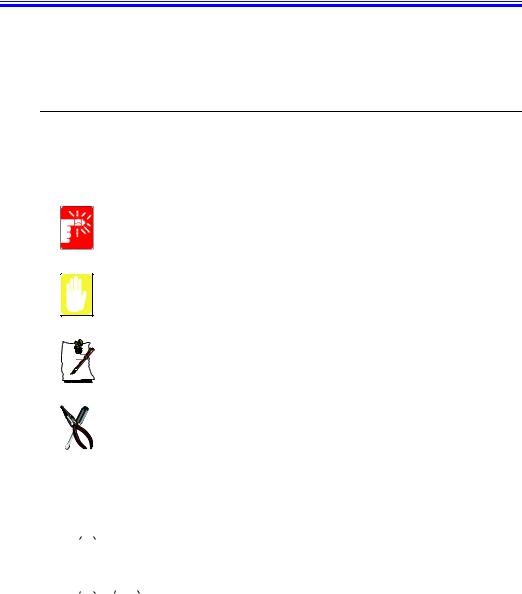
Using Your Documentation
Congratulations on your purchase of a notebook computer with the Windows® XP operating system. Whether you are new to using a portable computer or are an experienced user, this user’s manual can help you get the most from your computer.
Manual Documentation Conventions
Information Icons
Three icons and their associated messages appear in this manual. The information icons are placed before the step/information they apply to:
Warning:
Indicates the possibility of personal injury.
Caution:
Warns you of possible damage to equipment or data.
Note:
Informs you of special circumstances.
Technical Information:
Informs you of special requirements or limitations for use of item(s).
Keyboard Conventions
Keys that you need to press to perform certain functions are displayed in the manual using a small graphic of the button. For example: <Ctrl>
 or <Ctrl> indicates the control key (Ctrl on the keyboard).
or <Ctrl> indicates the control key (Ctrl on the keyboard).
If you need to press two keys at the same time, the key names are shown joined by a plus sign. For example:
 +
+  or <Fn+F8>
or <Fn+F8>
means that you should press the Fn key and hold it and then press the F8 key.
Using Your Documentation 1
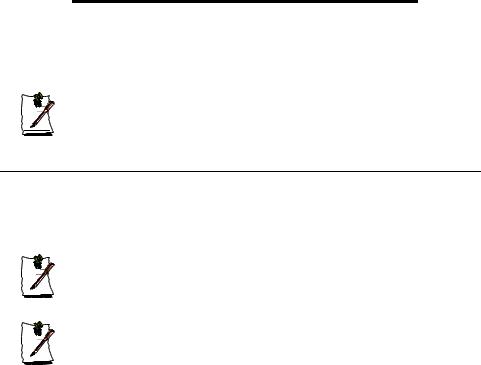
CD-ROM Device Naming Convention
In many installation programs you will have to get a program from the CD-ROM device. The program installation sequence assumes that the CD is drive d:\, however this is not always the case. The name of the CD-ROM drive is the letter following the letter assigned to your last HDD. For instance, if you have one HDD with two partitions, the HDD is drives C: and D: and the CD-ROM drive is then drive E.
Touchpad Conventions
You may be asked to click or double-click on items on the display screen. As a general note the touchpad actions act much in the same way as a wheel mouse, any differences are explained fully.
The object that needs to be clicked upon will be displayed in Bold text or shown in a small figure such as the “Start Button” shown on the right =>. 
Table 1. Touchpad Click Conventions
Action |
Process |
|
|
Click |
Depress the touchpad left button and release |
|
|
Double-Click |
Quickly click the left touchpad button two times |
|
|
Windows Conventions:
Almost all “Windows” programs will display the name/function of a button or icon if you place the touchpad pointer on the item you want information about.
Software User Documentation
Your computer is shipped from the factory with several software programs installed. The software may include its own online or printed documentation. Refer to the documentation or the Help options in the software for more information.
The figures and illustrations in this manual may not be identical to those on your system.
General Icon Note:
Some of the Icons used in Windows XP may be placed on the taskbar by selecting (ex: Place the volume icon in the taskbar) in the properties dialog box.
2 Users Manual

Introducing Your Computer
Your computer is a lightweight portable computer that includes features such as Dolby Digital & Dolby Theater System support, CD-ROM/floppy drives, Biometric (fingerprint) security system (factory option) and wireless LAN capability (factory option), to meet your computing needs at home or on the road. [Figures may be different depending on options).
Where Everything Is
The next 6 figures will explain the location of all of the buttons, LEDs and equipment needed to operate your notebook computer.
Front
LCD Latch
Power Button |
|
SENS Keyboard |
LEDs |
Buttons |
Biometric
Security
pad
Keyboard
Touchpad
Touchpad Buttons
 Internal Microphone
Internal Microphone
Speaker |
Speaker |
Power, Battery Status
& E-mail LEDs
Introducing Your Computer 3

Buttons and LEDs
Battery Status
Power Button
|
|
|
|
|
|
|
|
|
|
|
|
|
|
|
User |
|
|
|
|
Number Lock Icon |
|
|
|
|
|
|
|
|
|
|
|
Programmable |
|
|
|
Power |
|||
Caps Lock Icon |
|
|
|
|
|
|
|
|
|
|
|
|
Button |
|
E-Mail Alert |
||||
|
|
|
|
|
|
|
|
|
|
|
|
|
|
||||||
Scroll Lock Icon |
|
|
|
|
|
|
|
|
E-Mail Button |
|
|
|
|
||||||
|
|
|
|
|
|
|
|
|
|
|
|
||||||||
Drive Access Icon |
|
|
|
Internet Button |
|
|
|
|
|||||||||||
|
|
|
|
|
|
|
|||||||||||||
Right Side
FDD |
CD/DVD - ROM |
Fan Vent |
Hard Drive |
LAN Port |
Left Side
PC Card Eject Buttons PC Card Slot |
Battery |
|
Wheel Volume
TV-Out Port Fan Vent Security Lock Port 
 Control
Control
SPDIF In Jack
Line In Jack
Microphone Jack
Headphone Jack
4 Users Manual

Back Side
PS/2 Port |
|
|
|
|
|
|
|
|
|
1394 Port |
||
|
|
|
|
|
|
|
|
|||||
Modem Port |
|
|
|
Parallel |
Docking |
|
|
|
|
USB Ports |
||
|
|
|
|
|
||||||||
DC-In Port |
|
Printer Port |
Connector |
|
|
Fan Vent |
||||||
|
|
|
||||||||||
|
|
|
|
|
|
|||||||
|
|
|
|
|
|
|
External |
Monitor Port |
||||
|
|
|
|
|
|
|
||||||
Bottom
 Flex Bay Latch
Flex Bay Latch
Battery Compartment
Flex Bay Compartment
Memory
Compartment
Hard Drive
Mini PCI
Compartment
Introducing Your Computer 5

Using Your Computer for the First Time
This section gives you detailed information on using your computer for the first time.
Installing the Battery
To install the battery pack:
1.With the computer’s power off, close the LCD panel and turn the computer over so the bottom of the unit faces up.
2.Slide the battery compartment cover straight up and off the computer.
Insert the battery into the battery compartment, ensuring the correct orientation so that the battery fits in its slot properly.
3.Slide the battery pack into the compartment. Make sure the battery is fully inserted into the compartment.
4.Align the tabs on the battery compartment cover with the slots on the battery compartment.
5.Push the cover straight down until it snaps into place.
6 Users Manual

Attaching the AC Adapter
Your computer runs on power from the battery in the computer or from an electrical outlet. The first time that you use your computer, fully charge the battery by attaching the power cord to the computer and to an electrical outlet.
All batteries lose their charge if they sit unused for an extended time period.
When not used, battery can discharge fully in 2 to 3 months. The battery may
have discharged in the time it took for the computer to go from the factory to
you.
To attach the power cord:
1.Plug the AC adapter into the power connector on the back side of the computer.
2.Connect the power cord to the AC adapter and then to an electrical outlet.
AC Adapter
The battery starts charging as soon as you plug the power cord into an electrical outlet. The battery charges faster if the computer is turned off during charging.
If the battery is fully depleted and the computer is turned off, the battery charges in about 3 hours. If the computer is turned on, the battery charges in about 6 hours. When the battery is charging, the battery charge light is red. When the battery is fully charged, the light turns green.
See ”Using Power Management Options” on page 48 for more information on using your computer’s battery.
Using Your Computer for the First Time 7

Turning On the Computer
To turn on the computer’s power for the first time:
1.Slide the LCD latch, located on the front of the cover to the right.
2.Lift up the cover.
3.Press and then release the power button.
The power light is on when the computer’s power is on.
Power button
Cover Latch |
Power Light |
|
Initial Computer Startup:
The first time you start your computer you will see the operating system registration screens. Simply read each screen and follow the simple directions. You must complete this process in order to use your computer. A tutorial is provided if you require it.
Adjusting the LCD Display
You may wish to adjust the LCD (Liquid-Crystal Display) when you begin using your computer. A TFT (Thin-Film Transistor) LCD does not require adjustment for contrast because the contrast is set to remain at maximum.
To adjust the LCD:
•Press  +
+  <Fn+Right Arrow> to increase the display brightness.
<Fn+Right Arrow> to increase the display brightness.
•Press  +
+  <Fn+Left Arrow> to decrease the display brightness.
<Fn+Left Arrow> to decrease the display brightness.
8 Users Manual
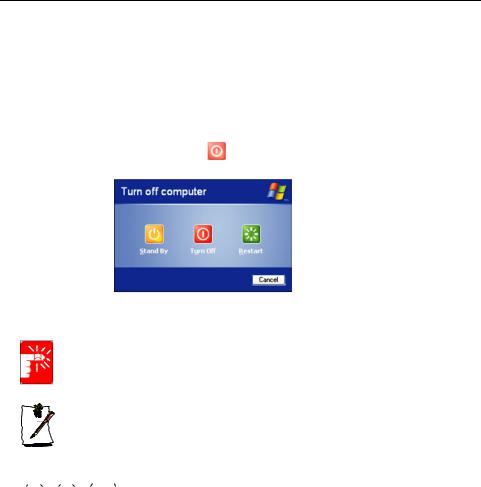
Turning Off Your Computer
Prior to shutting down your computer ensure all of your data and current work are saved. The system will ask if you wish to save any unsaved work, saving your work first will speed the shutdown process.
To turn off the computer, complete the following steps: 1. Click  on the taskbar.
on the taskbar.
If you need to restart your computer after software (re)installation or because it is not responding select the Restart  option in step 3 below.
option in step 3 below.
2.Click Shut Down Computer to display the shutdown popup window shown below.
3. Click Turn Off  to complete the shutdown sequence.
to complete the shutdown sequence.
Power Off:
If the system does not power off, then press and hold the power button for over 5 seconds. See ”Using Power Management Options” on page 48.
Power Button Functions:
The power button has several functions other than just turning on and off your computer, see “Using Power Management Options” on page 48.
You can also perform a soft boot by saving your files and pressing
 +
+  +
+  <Ctrl+Alt+Del> to pop-up the “Windows Task Manager” window. Click Shut Down > Restart.
<Ctrl+Alt+Del> to pop-up the “Windows Task Manager” window. Click Shut Down > Restart.
You can perform a cold boot by pressing the power button for more than 4 seconds to turn the computer off, waiting more than five seconds, and then pressing the power button to turn the computer on. The system may perform some extra checks during the restart.
Using Your Computer for the First Time 9

Tips for Using Your Computer
The following information helps you avoid potential problems as you use your computer:
Do not try to disassemble your computer. Opening the system chassis voids your warranty. Only an authorised manufacturer service center can replace or add any parts inside the chassis.
•Follow all the instructions and cautions in your computer user documentation.
•The LCD has a polarized surface and can be damaged easily. To prevent damage, avoid touching the screen.
•Use only approved AC adapters, auto adapters, memory modules and other options.
•Because a notebook computer is small and has restricted air flow around components, it is more likely to overheat than a desktop computer. A fan inside your computer runs when needed to help eliminate heat. Make sure the fan vent on the left side of your computer is not blocked when you use the computer. Occasionally check the vents and remove any accumulated dust on the outside.
•Avoid using or storing the computer in extremely hot or cold areas, such as a car on a hot day. Keep the computer away from heaters and out of direct sunlight. Exposure to excessive heat may damage computer components. If you have left your computer in a hot place, let it cool down slowly to room temperature (with the LCD panel open) before using it.
•Do not remove the memory-module compartment door, or try to install a memory module when the computer is on. (For information on installing memory modules, see “Installing a Memory Module” on page 60.)
•Set up your computer work area to avoid physical strain. Sit with your back straight and supported by your chair. Adjust your chair or work table so that your arms and wrists can remain in a relaxed position, parallel with the floor.
Avoid bending or twisting your wrists as you work. Your hands should “float” slightly above the keyboard. Refer to a book on office ergonomics for more information on setting up your work area.
•Take frequent breaks from working at the computer to rest your eyes and stretch your muscles.
•Remember to save your data files frequently and to make backup copies of your files.
10 Users Manual
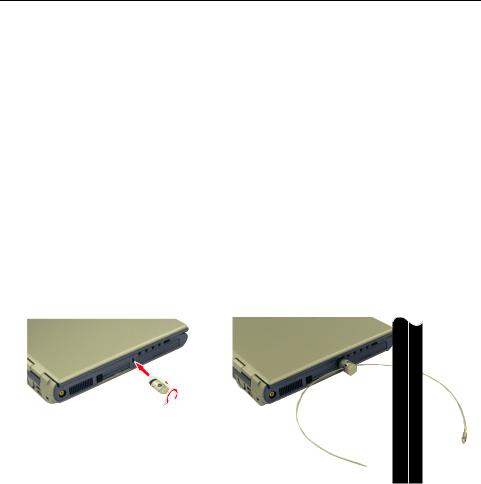
Travelling with Your Computer
Air Travel
If you are travelling by air, follow these tips:
•Take the computer with you as carry-on luggage. Do not check the computer with your baggage.
•Allow the computer and disks to go through the X-ray security devices. Do not hand-carry disks through the walk-through metal detectors, which can cause loss of data.
•Make sure that the battery is charged or the power cord is easily accessible. You may be required to turn on the computer for airport security personnel.
•Be prepared to turn off the computer during take off and landing.
Locking your Computer
As a precaution when you are travelling or using your computer in an unsecured area, you should keep your computer as safe as possible. An option to do this is the Security Lock System. Follow the Security Lock System manufacturers instructions for specific installation and use. The following figure shows generally how to use the lock.
To Lock
From Lock
Using Your Computer for the First Time 11
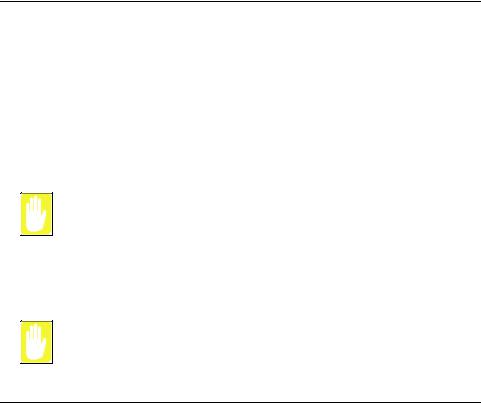
Handling Spills
Do not spill anything on your computer. The best way to avoid spills is to avoid eating and drinking around your computer. If you do spill something on your computer, turn off your computer, unplug it immediately, and do the following:
•If you spill liquid on the keyboard, drain as much of the liquid from the keyboard as possible. Be careful not to let the liquid drip onto the LCD panel. Allow the system to dry for several days before trying to use it.
•If you spill liquid on an external keyboard or keypad, unplug it and drain as much of the liquid as possible. Allow the keyboard to sit at room temperature for a full day before trying to use it.
Sweet liquids leave a sticky residue that may jam the keyboard despite your efforts to dry it.
•If you spill liquid on the LCD panel, clean it immediately with a soft cloth and denatured alcohol or a proprietary LCD screen cleaner. Do not use water, window cleaner, acetone, aromatic solvent, or dry, rough towels to clean it.
Some liquids damage the polarized LCD screen. If your screen is damaged, contact your authorized manufacturer’s service center for a replacement.
Storing the Computer for Long Periods
If possible, leave the power cord connected to the computer and an electrical outlet when the computer is not in use. This extends the life of the battery and keeps the battery fully charged.
If you will not be using the computer for a long period of time (a month or more), you should charge the battery until it is completely full. After you have done so, remove the battery from the unit.
12 Users Manual
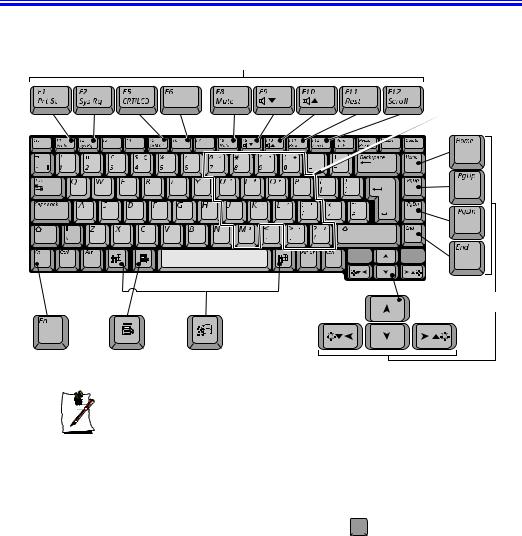
Using the Keyboard
Your computer has an 87/88-key keyboard. By pressing designated key combinations, you can have access to all the key functions of a full-sized keyboard.
Function & Special Purpose Keys
Gauge
Embedded
Numeric Keypad
Gauge |
Cursor/Screen
Control Keys
|
|
|
|
|
|
Function Key |
Application Key |
Windows Key |
|||
Although the layout of the keys on your computer’s keyboard is different from that on a desktop computer’s keyboard, the keyboard feels like a full-sized keyboard when you use it.
The keys on the keyboard can be grouped into the following categories:
•Full-sized Alphanumeric typewriter keys are arranged like a standard typewriter keyboard and are used for text entry. The Windows keys on either side of the spacebar open Windows menus and perform other special functions.
•Function keys, when pressed together with the  key, enable special
key, enable special
functions.
•Cursor and Screen control keys move the cursor. They may perform other functions, depending on your software.
To clean the computer keyboard, use slightly damp cotton swabs. Scrub the keys and the surface around the keys.
Using the Keyboard 13
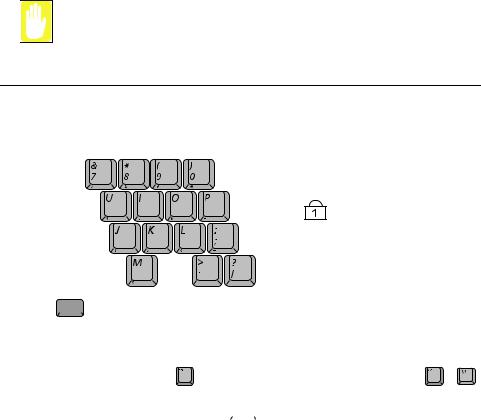
Do not allow liquid to drip into the keyboard or you may damage the keyboard.
Using the Numeric Keypad
Your keyboard includes a numeric keypad, which is a group of keys that you can set to type numbers and mathematical symbols, such as the plus sign. A number or symbol on the right corner of each keypad key shows its numeric function.
Num Lock LED
Press  to turn on the embedded numeric keypad. The numeric functions of the keypad are enabled and the Num Lock LED turns on. (See ”Reading the System Status Lights” on page 20 for the location of the Num Lock LED.)
to turn on the embedded numeric keypad. The numeric functions of the keypad are enabled and the Num Lock LED turns on. (See ”Reading the System Status Lights” on page 20 for the location of the Num Lock LED.)
While the numeric functions are enabled, you can temporarily return a key to its normal
function by pressing and the |
key. For example to type the letter m, press |
+ |
, |
this operation displays the letter m. |
|
|
|
To turn the numeric keypad off, press  again. The Num Lock LED turns off.
again. The Num Lock LED turns off.
14 Users Manual

Using Special Function Keys
The function key activates special functions when it is pressed in combination with another keys. Table 2 shows the special key combinations.
Table 2. Description of Special Function Key Combinations
Key |
Key |
Key Function |
||
Combinations |
Name |
|||
|
|
|||
|
|
|
|
|
+ |
F1 |
Print screen: |
Takes a picture of the open screen, which you can paste into |
|
Prt Sc |
|
many graphics programs. |
||
|
|
|
|
|
+ |
F2 |
System |
Reserved for use in software programs. |
|
Sys Rq |
request: |
|
||
|
|
|
|
|
+ |
F5 |
CRT/LCD: |
Switches the display between the LCD, the external monitor, |
|
CRT/LCD |
|
and simultaneous display on both the LCD and the external |
||
|
|
|
monitor. |
|
|
|
|
|
|
+ Gauge |
F6 |
Gauge |
Displays the battery gauge in the upper-right corner of your |
|
|
Gauge |
|
screen. |
|
|
|
|
The gauge closes in a few seconds, or you can press <Esc> |
|
|
|
|
to close the gauge. (See ”Monitoring the Battery Charge” on |
|
|
|
|
page 39 for more information on the battery gauge.) |
|
|
|
|
|
|
+ |
F8 |
Mute: |
Increases the audio volume. |
|
Mute |
|
|
||
|
|
|
|
|
+ |
F9 |
Volume |
Decreases the audio volume. |
|
Volume |
down: |
|
||
|
down: |
|
|
|
|
|
|
|
|
+ |
F10 |
Volume up: |
Increases the audio volume. |
|
Volume |
|
|
||
|
up: |
|
|
|
|
|
|
|
|
+ |
F11 |
Rest: |
Puts the computer into Suspend mode. To resume normal |
|
Rest: |
|
operation from rest, press the power button. (See ”Using |
||
|
|
|
Power Management Options” on page 48 for more |
|
|
|
|
information about the rest mode.) |
|
|
|
|
|
|
+ |
F12 |
Scroll: |
In some applications, sets the cursor-control keys to scroll |
|
Scroll |
|
the page up or down while the cursor position does not |
||
|
|
|
change. Pressing key combination again turns off the |
|
|
|
|
scrolling function. |
|
|
|
|
|
|
+ |
Left |
Brightness |
Decreases the LCD brightness. |
|
Arrow |
Down: |
|
||
|
|
|
|
|
+ |
Right |
Brightness |
Increases the LCD brightness. |
|
Arrow |
Up: |
|
||
When you press a function key combination, the system sound may be temporarily muted.
Using the Keyboard 15
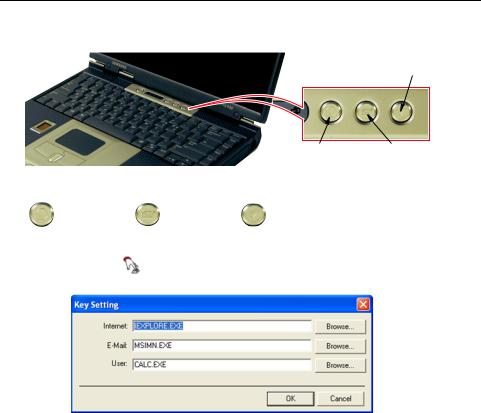
User Defined Buttons (SENS Keyboard)
You may program the three buttons to the right of the power button to start any program you have installed on your computer.
User defined program
Internet Explorer |
Outlook Express |
The default settings for these buttons are:
Internet |
E-Mail - Outlook |
Windows Calculator |
To reprogram the Sens Keyboard, follow the steps below:
1. Double-Click icon on the Windows taskbar, the Key Setting window is displayed.
2.Select Button you wish to reprogram from the drop down menus in the Key Setting window.
3.Use the Browse button to locate the program you wish to assign to the SENS Keyboard button selected.
4.Click on your program choice to select it.
5.Click Open.
6.Click OK to close window and complete programming the Sens Keyboard.
16 Users Manual
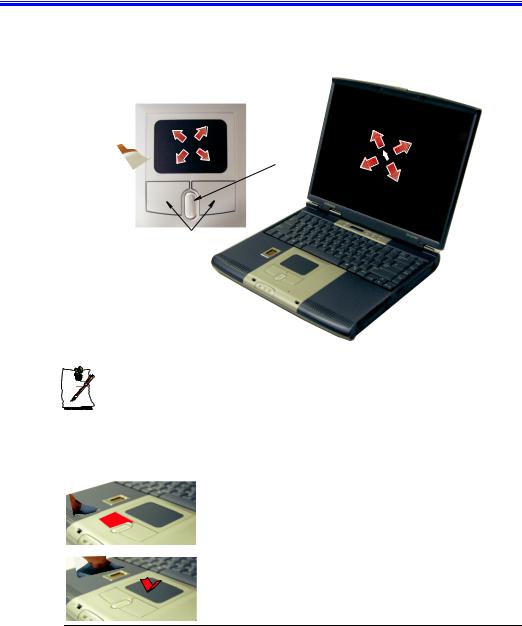
Using the Touchpad
Your computer is equipped with a touchpad, which is an integrated-pointing device that is used to perform standard mouse functions. The touchpad is an advanced and reliable pointing device that works with a touch of your finger.
Touchpad
Scroll Button
Mouse Buttons
Press on the touchpad gently. The touchpad responds to light pressure.
|
Table 3. Using the Touchpad |
Action |
Process and Comment |
|
|
Click/Tap |
Process |
|
|
|
Depress the touchpad left button and release or position the pointer |
|
over the object and Quickly tap the touchpad once with your finger. |
|
This action is called clicking. |
|
Comment |
|
This will cause a process to begin or select an object on the screen. |
Using the Touchpad 17
